General blood test from a finger and what diseases. What is a blood sample taken from a finger prick? What a therapist should know
A clinical blood test is taken from patients quite often, regardless of the diagnosis, and general analysis blood on an empty stomach is not always done. This practice is based on the fact that it is the most simple method diagnostics general condition body. But, in order for the analysis to be reliable, the patient must have proper preparation for the tests; for this, you can use the recommendations proposed in this article. This applies not only to questions such as: can you eat and drink before the procedure, but also other important aspects of human activity.
Preparations for the procedure
Preparation for a general blood test has its own characteristics.
For their part, specialists must strictly follow the instructions, and for the patient it is important to adhere to basic rules of behavior that will help the doctor obtain reliable results of a clinical analysis, namely:
- Try not to use tobacco products two hours before the test. This requirement is due to the fact that nicotine has negative influence on peripheral vessels, that is, during analysis, access to vital body fluid will be difficult. After donating blood, you can continue to lead your normal lifestyle.
- Do not drink strong tea or coffee before a general blood test; in this case, the reason for the prohibition is the same as with nicotine. In other cases, when patients wonder whether they can drink before taking a test, doctors do not limit the person’s fluid intake.

- Do not eat fatty foods before donating blood, and do not drink alcohol the day before the test. This is caused by the fact that cholesterol, which will be elevated due to taking the wrong foods, will negatively affect the ESR. Therefore, answering such a question as whether it is possible to eat before the analysis, experts answer - of course, yes, but only the food should be light and preferably several hours before the procedure.
- Some people who suffer from blood-related diseases wonder if they can drink medicines. In this case, doctors answer that the patient will have to stop taking medications that affect coagulation a day before the test. Even though a finger prick blood test is taken, the medications you take still have a huge impact. This recommendation is based on the fact that, otherwise, the effectiveness will be quite low, and this will certainly lead to an incorrect diagnosis.
- If a person is sick with a viral infection, then this test is not performed. He needs to be cured first and wait an additional week, only then go for testing. Otherwise, the infection will have negative impact on the indications of cellular composition, and this directly affects the process of treatment prescribed by the doctor.
- It is important that a general blood test can be carried out an hour after the last meal, which is strictly prohibited in the case of biochemical studies. But you need to know that you can eat foods that do not contain fatty foods, as well as those that have a high sugar content. In many clinics, finger prick blood is given on an empty stomach, although experts do not insist on this, because there are cases when a person cannot skip a meal for some reason, especially for children.
Factors influencing the result of the analysis
In addition to banal dietary restrictions, there are several factors that can affect end result analysis, such as:
- stressful situations or physical activity. In this case we're talking about about the body’s production of a certain type of hormones that distort the readings, especially if the stress occurred on an empty stomach. This means that before visiting a specialist, the patient should relax and calm down. If this condition is not met, then it does not matter whether a general blood test was taken on an empty stomach or not, the result may be distorted;
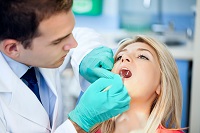
- a general analysis can be carried out only a week after the last medical procedures, such as gastroscopy or a visit to the dentist. This recommendation is due to the fact that such procedures change the level of leukocytes, which will lead to a false result. Therefore, every person should know how to prepare for the test and in what cases it should be postponed until authorized by specialists;
- cells undergo changes when enough time has passed after taking the analysis before performing the study itself large number time and here it no longer plays a role whether the preparation for taking a general blood test took place correctly. This happens when the laboratory is located at a remote distance and performing an analysis within a short time after collection is impossible.
boleznikrovi.com
Preparatory stage
To get the most accurate results and avoid the need for a second visit to the clinic, the following conditions must be met:
- Avoid smoking in the last two hours before the test. This requirement is due to the fact that nicotine can cause spasm of peripheral vessels, which will impede blood access to the extremities. As a result, analysis data may be distorted. For the same reason, you should not drink strong tea or coffee before donating blood.
- Do not consume fatty foods or alcohol on the eve of tests. These foods can cause an increase in blood cholesterol. And this, in turn, will affect the erythrocyte sedimentation rate, which is determined in this analysis.
- To ensure complete preparation for a blood test, it is not recommended to take certain medications that affect blood clotting. If at the time of donating blood you are undergoing treatment, you must notify the doctor about this and, if possible, reschedule the date of the test.
- You should not take this test during a viral infection, or for some time after it. The minimum period that must pass after recovery is 7 days. This requirement is due to the fact that this disease affects the cellular composition of the blood, therefore, the test results will be unreliable.
Finger blood test
In addition to the general clinical picture, this analysis will help determine other indicators of changes in the body. Typically this is initial stage donating blood. If your doctor identifies any abnormalities, tests will have to be continued to find the exact cause of the changes in the body.
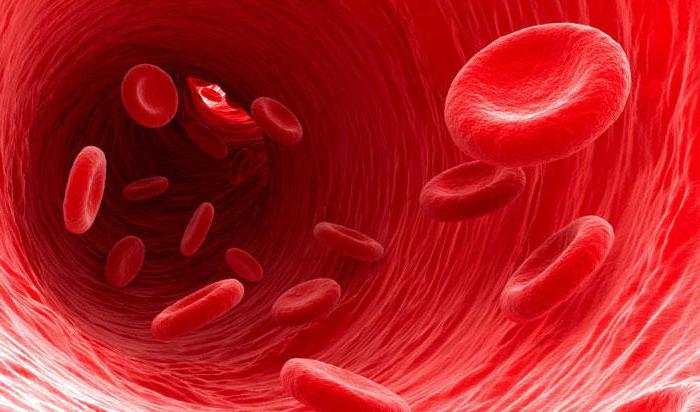
So, in addition to the general clinical picture, a finger prick blood test determines:
- hemoglobin level in the body;
- the presence of various infections (bacterial or viral);
- blood sugar level.
These indicators may change when eating certain foods, exercising and drinking alcohol. That is why the question: “general blood test - on an empty stomach or not” should not be asked. If you are going to donate blood from a finger prick, you should eat no later than 8 hours before the procedure. In the case when the sugar level is measured, it is recommended to abstain not only from food, but also from water and even chewing gum.
Blood test from a vein
This method blood sampling gradually completely replaces the first. Today, a general blood test can be taken not only from a finger, but also from a vein. At the same time, the latter method is gaining popularity as it provides a more complete clinical picture.
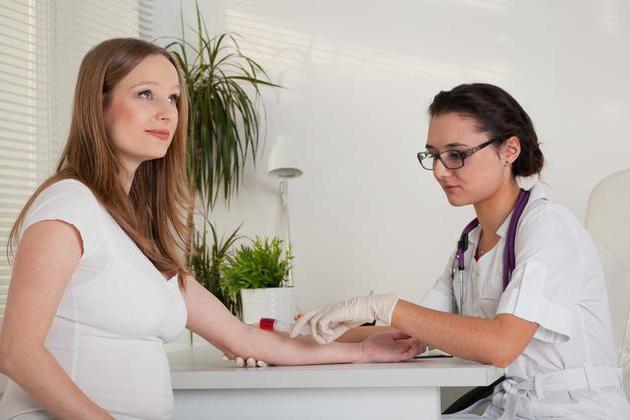
Thus, by donating blood once, you can get the results of many tests, which is very convenient.
So, you can take a blood test from a vein if you want to determine:
- your blood type and Rh factor (this indicator can also be detected by taking a finger prick test);
- biochemical composition;
- hormonal background;
- the presence of sexually transmitted infections;
- level of tumor markers.
It is noteworthy that before taking a blood test from a vein for all these indicators, you can eat lightly. An exception is the analysis of TSH and parahormone hormones. In addition, if you want to be examined for HIV infection, hepatitis or syphilis, doctors strongly recommend donating blood exclusively on an empty stomach.
Hidden blood: method of determination
Among the many studies that modern medicine offers, the occult blood test stands out. This is a method of examining stool, which is done to detect hidden bleeding from different parts of the gastrointestinal tract. This is an extremely important laboratory test that allows you to diagnose the onset of various serious illnesses, which cannot be detected otherwise.
To obtain reliable results, three days before taking the test for hidden blood, you must exclude meat, fish, green vegetables and tomatoes from the diet. In addition, you should stop using any laxatives that may affect bowel function. It should be remembered that the reliability of the analysis result, and therefore the correctness of the diagnosis, depends on proper preparation.
Blood test during pregnancy
Expecting a child is the most wonderful time in a woman’s life. However, in addition to the joyful feeling of the birth of life, this period is characterized by the need to regularly visit the antenatal clinic.
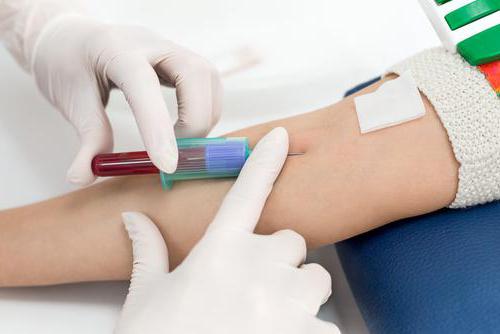
With all the variety of tests that must be taken expectant mother Throughout pregnancy, general blood and urine tests are regular. To professionally monitor the course of pregnancy, it is necessary to take them at least once a month. At the same time, if urine can be collected in the morning immediately after waking up, then the question “general blood test - on an empty stomach or not” is quite controversial.
Pregnancy is a period of life when a woman needs to regularly consume calories and such a long gap between meals can negatively affect her health. Therefore, doctors allow a light breakfast before donating blood. As for water, you can drink it without restrictions.
General blood test in children
Children are a category of patients that require a special approach. What does a child's blood test mean? This is a comprehensive diagnosis that allows you to determine the progress of the child’s development and the presence of both the diseases themselves and the prerequisites for them.
In this case, the preparation procedure depends on the age of the small patient. If the child is under one year old, then taking tests on an empty stomach is out of the question. The time that must be maintained from the moment of eating is three hours. If it takes longer, that’s good, but a three-hour interval is necessary.
Children aged one year and above should try to explain the importance of this analysis and prepare for the procedure. Taking blood tests in young patients is usually accompanied by negative emotions, which can lead to stagnation of blood, which will consequently complicate the procedure for collecting it.
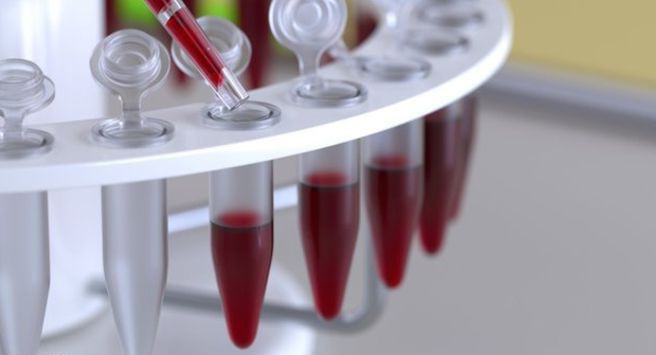
Therefore, it is extremely important to try to create a positive attitude in children, in which they will not be afraid of doctors and possible pain. It is advisable to exclude physical activity the day before the visit to the clinic, and high-fat foods should be removed from the diet. Directly during the blood draw itself, it is necessary to distract the baby. This can be done either by talking or with your favorite toy. Following these recommendations will allow you to get the most reliable results without psychological stress.
Where can I get a blood test?
If there is a need to donate blood, you have a choice between the public clinic to which you belong geographically and a private medical center. It all depends on your desire and financial capabilities.
Today there are many private laboratories that have the latest equipment. However, not everyone can afford to pay the required amount for the examination. In this case, you can go to a clinic located in your area of residence.

Cost of blood test
Those wishing to undergo a medical examination are interested in how much a blood test costs. Reply to this question depends on several factors, such as the choice of laboratory and type of analysis. If you have a compulsory health insurance policy, a blood test in public clinics will be done for free. This applies to a medical facility located in your area of residence. If for some reason you want to get tested at another public clinic, having a policy will provide free medical care.
Regarding private laboratories and medical centers, here the cost of each analysis depends on the price category set by the institution. For example, the price of a clinical blood test depends on the depth of the study. The cost varies from 150 to 650 rubles. The price of a biochemical analysis from a vein is determined by the type of analysis: if the level of certain antibodies is examined, the cost usually ranges from 150 to 300 rubles. Prices for tests for hormones and tumor markers start from 300 rubles. Determining the presence of viral infections and the amount of antibodies in the body costs about 400 rubles and depends on the complexity of the manipulation. At the same time, comprehensive blood donation for the presence of any infections, as a rule, allows you to save money. In any case, having chosen the place where you want to donate blood, you should familiarize yourself with the services provided and their costs in order to know the exact price you will have to pay for the procedure.
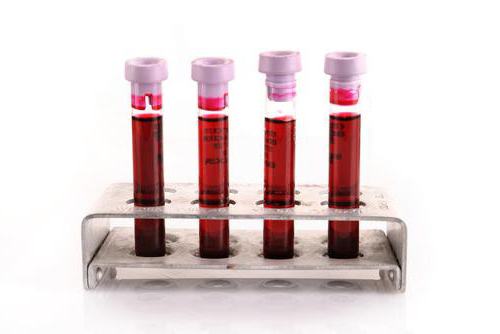
Conclusion
Thus, donating blood is a procedure that every person thinking about own health. How to take a general blood test, on an empty stomach or not, depends on the state of health, the purpose of the examination and the disease being determined. In any case, if the doctor has prescribed you to donate blood, you need to clarify with him what preparation requirements are required for a specific test.
fb.ru
How and why is a general blood test done?
General clinical analysis is the simplest and most informative method medical research. Based on its results, you can accurately diagnose a number of serious ailments, such as anemia or anemia, infections, inflammation and many others. The laboratory technician uses sterile disposable instruments and wears gloves to collect blood. Blood is taken from ring finger, most often the left hand.
A clinical blood test is most often used to diagnose the disease. U healthy person the blood contains a certain norm of various elements: hemoglobin, leukocytes, erythrocytes, platelets, lymphocytes and some others. Sometimes these indicators deviate from the norm due to physical activity or climatic conditions. If normative deviations are influenced by other factors, this indicates the presence of a disease in the human body.
A person who does not have a medical education will most likely not be able to independently understand what he is talking about and what the analysis shows. If the state of health is satisfactory, all indicators should be normal. In case of any deviations, you should definitely pay attention to this.
The procedure for conducting a clinical analysis is not at all complicated. But in order for the results to be correct, it is necessary to prepare the body in advance.
Instructions for preparing for a clinical blood test:

When a health problem arises, any doctor will first send you for a general clinical blood test. The results of the analysis make it possible to see the presence of pathological diseases or inflammatory processes in the body, gives an idea of the patient’s immune system and allows you to select the necessary treatment. In order to see real blood values, you should not neglect simple rules preparation before going to the clinic.
101analiz.ru
Influence of external factors
Clinical test results may be influenced by certain external factors. To donate blood correctly, you should exclude them:
- Intense physical activity and stress lead to the release of certain hormones into the human bloodstream, which can distort the values of basic indicators. Therefore, before entering treatment room, you should rest and relax. Fifteen minutes is enough for this.
- Invasive diagnostic techniques (gastroscopy, colonoscopy), dental operations can change the level of leukocytes. Therefore, in order to obtain a reliable result, it is not advisable to perform the analysis within a week after such interventions.
- The result of the study can also be influenced by the reagents with which it is carried out. That is why indicators may differ in different laboratories. If a control study is necessary, a general blood test is taken in the same laboratory. Otherwise, the results cannot be compared.
- The values of some indicators also change with a long time interval between blood sampling and analysis. This usually occurs when sample tubes are transported to a laboratory located in another location. Under the influence of preservatives, blood cells begin to break down, which leads to significant deviations in the results.
How is the sample taken?
A general blood test is most often taken from a finger, that is, capillary blood is examined. In this case, it is very important that the rules for collecting biological fluid are followed. The alcohol remaining after disinfection has a huge impact on the analysis result. Therefore, before pricking your finger with a scarifier, you should thoroughly wipe it with a sterile, dry cloth.
However, in order to conduct a detailed blood test, capillary blood 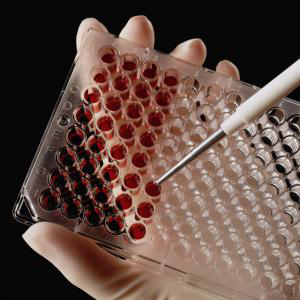 may not be enough. In this case, blood is taken from a vein. Previously, a regular syringe was used for this. However, when passing through a thin needle, blood cells underwent significant transformation, which affected the result of the study. Currently, special vacuum containers are used to collect fluid, into which blood is sucked in independently under the influence of negative pressure. This improves the accuracy of the results.
may not be enough. In this case, blood is taken from a vein. Previously, a regular syringe was used for this. However, when passing through a thin needle, blood cells underwent significant transformation, which affected the result of the study. Currently, special vacuum containers are used to collect fluid, into which blood is sucked in independently under the influence of negative pressure. This improves the accuracy of the results.
Features in children
If a clinical test is prescribed for a child, then special preparation of the patient is required. First of all, this concerns psychological support. It is known that the results of the study can be influenced emotional state and physical activity. Children often experience fear of doctors, nurses, and injections. In this regard, babies begin to resist and cry, which provokes the release of certain hormones into the blood.
To prevent this, it is advisable to tell the child in advance about what will happen to him in the treatment room. You should explain to the baby that it will hurt a little and he needs to be patient. During the collection of biological material, you can distract the little patient with some kind of toy. And after completing the analysis, treat them with sweets or juice. The remaining rules for preparing for analysis are similar to those for adults.
However, due to increased reactivity immune system child's body, it is advisable not to feed the child before performing the study. This may affect the white blood cell count, leading to a false diagnosis of an infectious process. The golden rule when taking a clinical blood test is that if any abnormalities are detected, a repeat test should be performed in the same laboratory. Only if there are similar changes in two tests can the disease be diagnosed.
www.infmedserv.ru
Adults and children at the treatment room
“> Blood from a finger is taken for a general analysis to diagnose sugar, as well as to determine the norm and level of red blood cells, platelets, hemoglobin, monocytes, and leukocytes. The decoding gives an idea of the structure of reticulocytes, ESR, leukocytes, the presence of infectious, inflammatory pathologies, and deviations of indicators from the norm. A biochemical, general analysis for sugar is taken in both adults and children. In this vein, donating blood fluid has its own typical patterns. Before taking blood, it is clear to the laboratory assistant at first glance who will undergo the “scary” procedure.
Adults, as a rule, are not afraid of a general blood test. They behave naturally and at ease, but if the manipulation is a child, especially a small one, this fact immediately catches the eye. The whims of children can be understood. Feeling and seeing living flesh being pierced is an unattractive pleasure. Therefore, the child must first be prepared at home. Without going into details of the various psychological techniques you can simply promise him something, clarify what surprise he expects.
There are laboratories for collecting blood for sugar in virtually any clinic or within a medical architectural group. Before taking a biochemical and general analysis, the child should not be nervous or bothered over trifles. It is important that he behave calmly before donating blood fluid. In an excited child, the normal indicators will be distorted, since the psycho-emotional state increases the level of certain blood elements. However, the main question that remains open is whether it is possible to donate blood on an empty stomach or give the baby a snack before going to the laboratory.
Many doctors say the following in this regard: it is not necessary in every case to starve him in the morning. That is, you only need to donate blood fluid on an empty stomach in a few cases: for sugar, biochemistry, HIV. Something else is also important. It is highly advisable to give him a drink of water before going for a blood draw. That is, essentially, when a referral is issued, it is better to ask the doctor whether the test is being taken on an empty stomach or not.
What a therapist should know
In adults similar picture. A number of rules must be followed before visiting the treatment room. That is, the general analysis is preceded by a little preparation.
- Pay attention to the reception medicines so that the blood rate is not distorted.
- Tell the doctor about the date of excessive physical and emotional stress.
- Find out how to take tests - before eating or you can eat before the procedure.
- Inform about smoking and drinking alcohol.
- Ask how recent physical procedures (if any) will affect the clinical analysis.
For women there is additional set rules They must notify their GP about their monthly cycle before going to have their blood drawn. Inform about pregnancy and menopause. These and other important nuances will affect the deciphering of the blood norm results.
If the doctor has ordered you to take a clinical test on an empty stomach, you should do so. Don’t eat anything in the morning, but go for a blood draw. As a rule, it is taken between 8.00 and 11.00, but often blood fluid is taken for examination after this time. To properly prepare yourself means to help the doctor create an accurate clinical picture of what is happening in the body. Regardless of the prohibitions, you can drink some water if you are really thirsty. Important:
- Blood sampling is a responsible procedure, so sweet compote should be excluded from the morning menu.
- Before the day of delivery, do not eat smoked, spicy, overly salty or fatty foods.
- Avoid alcohol and excessive physical activity. All this will equally affect the overall analysis.
- Preparation for the procedure involves avoiding many types of medications.
You need to notify your doctor about all this. He has the right to say that the blood draw can be postponed to a later date.
No more painful than a finger
Besides general recommendations, many health workers are still inclined to say that they must donate blood on an empty stomach. Only in this case, the norm, the required indicators, and the decoding of all important microelements will reflect the real clinical result. The point of view is based on the fact that detection of triglycerides, cholesterol, lipids can be expected only after a 12-15 hour fast. The same applies when you need to determine the sugar level. Only in this case, analysis in adults correctly shows the real clinical picture. Therefore, donating blood on an empty stomach is a common requirement among doctors.
Another question is how accurate the interpretation of a blood test taken from a finger will be. Not everything is clear here. Blood fluid is taken from a vein to make the diagnosis better and more comprehensive. To recognize the pathology in time, there is no need to “torment” the finger. You need to take blood from a vein.
The laboratories where blood is taken are staffed exclusively by highly qualified health workers who know how to communicate with children.
However, adults also often need to be convinced that a blood test from a vein is a necessary procedure that will show the norm or various abnormalities. Also, the list of responsibilities of doctors involved in blood sampling includes the ability to work with the complex structure of the vein from which a sample of biomaterial will be taken. Today there is no need to worry about this . The procedure is safe and takes minimal time from the patient. Adults and even children tend to tolerate minor stress easily.
Venous or capillary
A blood test taken from a vein shows much larger number parameters. There is no need to remind you that before such a procedure it is also important to comply with a number of conditions, for example, to take it on an empty stomach. Using blood taken from a vein, you can determine:
- some types of infections;
- more accurate diagnosis (normal, deviations from the required indicators);
- determination of the content of erythrocytes, leukocytes, neutrophils, platelets, lymphocytes, eosinophils, color index, ESR;
- excess sugar content;
- the presence of antibodies, the amount of hormones.
The doctor will read all these and other indicators on a form with the results of a blood test taken from a vein. So in many cases, a capillary blood test is not enough.
okrovi.ru
Preparing to donate blood
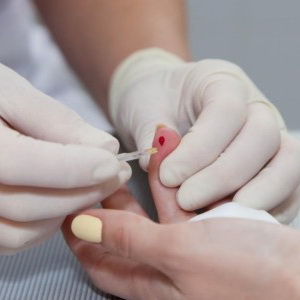 To get the most accurate blood test results, preparations need to be made. It consists of abstaining from using tobacco and eating for a certain time before taking blood. It is not advisable to smoke at least two hours before the test. The last evening meal should occur at least 8 hours before the test, which is why blood is donated mainly in the morning. Before taking blood, it is not recommended to drink strong tea or alcohol.
To get the most accurate blood test results, preparations need to be made. It consists of abstaining from using tobacco and eating for a certain time before taking blood. It is not advisable to smoke at least two hours before the test. The last evening meal should occur at least 8 hours before the test, which is why blood is donated mainly in the morning. Before taking blood, it is not recommended to drink strong tea or alcohol.
Don't eat a large dinner fatty foods, since an increase in blood cholesterol levels may negatively affect the obtained data. This directly concerns the rate at which red blood cells settle, which is studied during this study.
It is not recommended to take certain medications before taking the test. blood thinners. If the course of treatment cannot be interrupted, you should warn the doctor or laboratory technician so that they make a note in the test results for a more accurate interpretation.
If you suspect viral infection or 7 days after completing her treatment, a blood test is not recommended. This is due to the fact that the cellular composition of the blood undergoes some changes and the tests will be unreliable.
Is it necessary to take the test on an empty stomach or not?
Any analysis is recommended take on an empty stomach. This is one of the basic requirements that must be carefully observed when undergoing a medical examination. However, it is worth knowing that fasting does not mean a complete refusal of food. An early dinner is enough, which will take place no later than 8 pm. After the analysis itself, it is quite possible for a person to have a snack or even a hearty breakfast.
When taking a general blood test, if a person is unable to eat immediately after the test, you can eat before taking the blood test. This can be any porridge cooked without milk, sugar or butter, a little unsweetened and weak tea and an apple. But, if a blood test is carried out to study a person’s condition during illness, the conditions for taking the test must be observed at all times.
After eating leukocyte concentration increases in the blood, so in order not to comply with the same test conditions every time, it is recommended to donate blood on an empty stomach.
What does the analysis show?
A general blood test or capillary blood test allows you to determine the concentration in the blood of such bodies or substances as:
- hemoglobin;
- red blood cells;
- reticulocytes;
- platelets;
- leukocytes;
- lymphocytes;
- monocytes.
Some time after undergoing the analysis, the patient receives the results of the study. The hemoglobin test allows you to evaluate the transport function of the blood. Hemoglobin is a component of red blood cells. It is due to its presence that the blood acquires a peculiar color. Hemoglobin is able to attract oxygen and transport it to tissues and cells in the body. In this case, on the way back, oxygen is replaced by carbon dioxide and in the same way it is removed from the body.
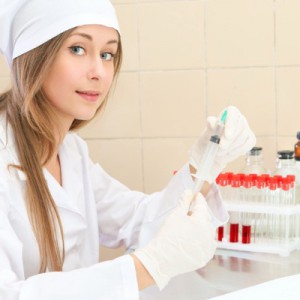 The normal concentration of hemoglobin in the blood varies from 130 to 160 g/l in men and from 120 to 140 g/l in women. If the concentration of hemoglobin in the blood decreases, the doctor can judge whether a person has heart defects or intestinal obstruction. During dehydration, the hemoglobin level increases.
The normal concentration of hemoglobin in the blood varies from 130 to 160 g/l in men and from 120 to 140 g/l in women. If the concentration of hemoglobin in the blood decreases, the doctor can judge whether a person has heart defects or intestinal obstruction. During dehydration, the hemoglobin level increases.
Erythrocytes or red blood cells perform a transport function in the blood. Their normal concentration varies from 4 to 5 g/l in men and from 3.7 to 4.7 g/l in women. If the indicator decreases, the doctor can judge large blood losses and overhydration. When the concentration of red blood cells increases, we can talk about the presence of neoplasms in the body, kidney disease, Cushing's syndrome, burns, taking diuretics, and diarrhea.
Reticulocytes are immature red blood cells. They are produced in the bone marrow and released into the blood in small quantities. Their concentration in the blood can reach 1.2%. With the development of anemia, their coefficient decreases. The same effect is achieved in diseases of the kidneys and genitourinary system, and folic deficiency anemia. An increase in reticulocyte counts is observed with hemorrhages and anemia.
Platelets or red blood plates are the main elements of blood. Their task is to protect the body from blood loss. That is, when blood vessels are damaged, platelets collect at the site of damage and form a blood clot. Normal values vary from 180 to 320 by 10 to the 9th power units per liter.
If the platelet concentration increases, the doctor can diagnose myeloid leukemia, arthritis, polycythemia, tuberculosis, or various types of inflammatory processes. If the parameter decreases, the patient may be diagnosed with anemia, hemolytic diseases, and lupus erythematosus.
Leukocytes, like platelets, protect the body. Their task is to produce antibodies to protect humans from antibodies. They are responsible for the quality of immunity. Normal concentrations of these cells in the blood vary from 4 to 9 by 10 to the 9th power units per liter. The indicator decreases with hypoplasia, typhoid, oncology, ARVI, rubella, hepatitis, leukemia, lupus. An increase in indicators is observed with pneumonia, sepsis, inflammation, meningitis, pancreatitis, bronchitis.
How long does the analysis take?
There are a large number of different studies of the state of the blood and the concentration of individual elements in it, these are:
- general analysis;
- blood group;
- analysis for hepatitis, syphilis, HIV.
Each of the studies carried out can be carried out both for the personal interest of a person, and for analyzes aimed at determining the state of health. The study of capillary blood for general analysis involves calculating the volume of hemoglobin, red blood cells, leukocytes and other blood cells, as well as study of leukocyte formula and the rate at which red blood cells settle.
Similar tests are carried out to diagnose hematological, inflammatory or infectious diseases, and a blood test also allows you to monitor changes in a person’s health status during treatment.
To conduct a general study it is required approximately two hours. During this time, the laboratory manages to obtain all the data on the state of the blood. When calculating a blood group, doctors study it according to a special AVO system. This test is usually performed before a blood transfusion or during pregnancy. Newborn babies are often prescribed this test to detect various types of hematological diseases.
A rapid test for hepatitis is also performed during the study of capillary blood tests. The laboratory is studying antibodies to this virus. At the same time, you can get the analysis results after a quarter of an hour. A rapid test for syphilis is similar to a blood test for hepatitis, but the presence and volume of bacteria belonging to the Treponema pallidum species is studied.
As with the hepatitis test, the results of the study can be obtained already in 15 minutes.
Some tests are held for several days. These are tests such as:
- glucose test;
- biochemical analysis;
- blood test for HIV;
- study of antibodies to hepatitis;
- test for syphilis;
- study of hemostasis;
- hormone research.
 You can receive data on blood sugar tests the very next day. It is prescribed to study blood for glucose content. Tests are performed to monitor blood sugar levels and make a diagnosis. diabetes mellitus or to control a given disease.
You can receive data on blood sugar tests the very next day. It is prescribed to study blood for glucose content. Tests are performed to monitor blood sugar levels and make a diagnosis. diabetes mellitus or to control a given disease.
Studying blood for HIV in laboratories helps to identify the presence of antibodies in it for this infection. Venous blood is used for analysis. The research results are ready within 10 days. Blood tests for syphilis are carried out in laboratories for about a week. A blood test for hepatitis takes up to two weeks.
The study of hormonal levels is carried out depending on their type, as well as on the phase life cycle women. Typically, test results are received within two to 30 days. Capillary blood testing is carried out for various diseases and for any visits to the doctor.
Special requirements for preparing for the test include the mandatory examination on an empty stomach. This is not mandatory rule However, the same conditions must be observed when taking the test several times during treatment.
medickon.com
What is a complete blood count?
Blood is one of the tissues of the body, which reflects all the processes occurring in it.
You can find pathogens in the blood, determine the cause of the disease by specific cell damage, examine the state of the immune system, the level of hormones, enzymes and other substances.
There are several hundred parameters that will directly or indirectly indicate the cause of the disease.
All the tests will require too much blood and time, so doctors don’t act like that. To begin a successful diagnosis, you need to determine its general direction.
Several assays exist to achieve this goal. One of them is a general blood test.
A general or clinical blood test, abbreviated as CBC, is one of the most common laboratory tests.
In many ways, this is an ideal diagnostic method - simple, cheap, fast and quite accurately reflecting negative changes in the body.
It studies the condition of the main blood cells, which are also called formed elements. These are red blood cells, platelets and leukocytes.
Red blood cells in many ways have the right to be called the main blood cells. Firstly, there are truly a huge number of them!
UAC determines their number in pieces per liter, and the resulting number always contains 12 zeros. Every second, the bone marrow supplies 2.4 million new red blood cells.
Hemoglobin, which makes up 98% of all proteins in the cytoplasm of red blood cells, gives blood its color.
Red blood cells complete the respiratory process: they carry oxygen from the lungs to all tissues of the body and deliver carbon dioxide, which the lungs remove to the outside.
Platelets provide the desired thickness. If there is a lack of them, a person can suffer from blood loss even after minor tissue damage, but if there are too many of them, there is a risk of blood clots and blockage of blood flow.
If erythrocytes and platelets are cells that are homogeneous in their composition, then leukocytes are a whole group of cells that are dissimilar to each other.
This is due to the task they perform - protecting the body from invasion.
Viruses, bacteria, fungi, foreign bodies - no matter what enemy encroaches on the health of systems and organs, he will definitely have to face leukocytes.
Based on the foregoing, it is clear that the study of blood cells provides information about the functioning of several main body systems, which allows us to accurately determine the further direction of diagnosis.
Preparing for the UAC
Did you know that a doctor in a public clinic has 7 minutes to consult one patient?
If the latter only needs to be sent for examination, then the doctor should do it in 5 minutes. Time is money, and the state, which pays salaries to its specialists, wants them to manage their time as efficiently as possible.
It is not surprising that in such conditions doctors do not have time to provide much important information, sometimes even mention whether it is necessary to take the test on an empty stomach.
Fortunately, there is no shortage of it in modern world no, and patients are increasingly aware own responsibility for your health, the success of examination and treatment.
It is desirable that all conditions under which the analysis is performed coincide. The result obtained will be more correct if the analysis is performed in one laboratory.
A general blood test is taken either on an empty stomach or after breakfast. The time of blood sampling is also important, since immediately after sleep the number of red blood cells is higher, which means it is better to take the test at the same time.
Capillary and venous blood are somewhat different, but for general analysis these differences are not significant.
Typically, blood is taken from a finger prick because only a few drops are needed, but if you had blood taken from a vein during your illness, the laboratory may use it for a general analysis.
In this case, the blood for subsequent control tests must also be venous.
To collect blood from a finger, a scarifier is most often used - a metal plate with a pointed spike at the end.
The thorn is not very thin, so the puncture is quite painful, given that there are many nerve endings on the fingertips.
The scarifier has an alternative - a lancet. This is a plastic device that resembles a ballpoint pen, in which instead of a rod there is a thin needle.
When you press the button, it extends just enough for almost painless blood collection. The most important disadvantage of the lancet is its high cost.
Before donating blood for any test, you should not take medications, smoke, undergo physiotherapeutic procedures, undergo an X-ray examination, and much more.
Be sure to notify your doctor or specialist diagnostic clinic about possible interference with the survey.
Is it possible to have breakfast before the OAC?
There are several general requirements that are important to meet before donating blood for any test. One of these requirements is that blood must be donated on an empty stomach.
Fasting does not mean that the patient should starve himself. If you have an early dinner, get eight hours of sleep, and take the test early in the morning, taking a sandwich with you to eat immediately after the blood draw is enough to meet the fasting requirement.
Some tests, such as blood chemistry tests, may require several days of a special diet because certain products influence blood biochemistry.
For example, citrus fruits, pumpkin or a number of other foods eaten the day before will distort the picture of liver enzymes, and pork steak will raise the level of urea and potassium.
And this is only a hundredth part of the distortions that can be avoided if you know what you can eat and what you have to abstain from.
The general analysis mainly examines the formed elements of the blood, which are not significantly affected by food, so there is no strict requirement to donate blood on an empty stomach.
No later than an hour before the analysis is allowed light breakfast from porridge (without butter, milk or sugar), unsweetened tea and apple. However, there is one important point.
If during one illness or to control one condition a general blood test is taken several times, the conditions must be exactly the same.
For example, the number of white blood cells increases slightly after eating. In other words, if you took a general test without an empty stomach for the first time after the onset of the disease, then before each subsequent test you need to eat the same thing to monitor treatment.
It may be much more convenient to donate blood on an empty stomach than to keep in mind the additional conditions under which you donated it the first time.
Norm and pathology when deciphering the CBC
So, the preparation and blood collection procedure are over, you did everything correctly and even donated blood on an empty stomach just in case.
A few hours after the analysis, you received a form with the results of a clinical blood test.
It's easy to relate eigenvalues with ranges accepted as the norm - just find the relevant information on the Internet.
But it is important to understand well what a norm is, because this is a relative concept.
The norm depends on gender (most indicators differ in men and women) and age. From birth to the end of the first year of life, the normal blood flow rate changes as many as five times!
The norm will also differ depending on various conditions of the body, for example, during pregnancy or on certain types of diet.
If you want to read the test results yourself, it is important to accurately determine your own norm.
Doctors do not favor “overly smart” patients not because they are afraid of competition, but because of the far-reaching and, as a rule, erroneous conclusions that they tend to draw.
The second conclusion follows from this: even if you discover deviations from the normal blood flow rate in yourself or your loved ones, you do not need to make a diagnosis, because it is extremely unlikely that it will turn out to be correct.
The doctor does not simply compare indicators that are outside the normal range with a list of possible diseases and select the most appropriate options.
It is important to consider not individual indicators, but their totality. There are many reasons why the number of platelets, red blood cells or the sedimentation rate of the latter may be abnormal, and not all of them are symptoms.
For example, your platelet count may decrease due to menstruation or poor nutrition.
Before making a diagnosis, it is important to make sure that the decrease or increase in one or more indicators is stable and not caused by understandable reasons not related to health problems.
Why all these tests that doctors force us to take? How is blood from a vein different from blood from a finger? What do the numbers on the analysis results sheet say?
Blood reacts quickly to the slightest changes in health. That is why the first test that a doctor prescribes is a general blood test.
The procedure is simple: a light 2-mm puncture is made on the fingertip with a disposable scarifier needle; A drop of blood immediately appears. If it is not enough, the nurse will apply light pressure with your finger and draw blood into a pipette. And then either a cunning imported device or the sharp eye of an experienced laboratory doctor will calculate how much of what you have.
|
Indicator |
Abbreviated name. Content standard |
Decoding BY THE WAY Some people fast in the evening before the test - they believe that blood should be donated in the morning and always on an empty stomach. Nothing of the kind: for a general blood test it does not matter. True, you shouldn’t eat potatoes with lard at night, otherwise in the morning there will probably be more leukocytes than usual! But after drinking alcoholic beverages, sunbathing and physiotherapy, as well as after an X-ray examination, it is better to wait a few days, otherwise the results will be “defective”. |
A clinical blood test is considered the most popular laboratory examination, prescribed for diagnostic purposes, for prevention, monitoring of pregnancy and the health status of patients. any age.
To obtain results, you need to donate blood from the capillaries of your finger for a general analysis. The rules and algorithm for sampling are very familiar to every person. Every year the doctor reminds you that the test must be taken in the morning and always on an empty stomach, and you can eat only after taking the sample. This manipulation is quite simple, and the answers can be collected from the laboratory the very next day.
Laboratory examination
Blood from a finger: what does it show?
In addition to a clinical blood test (cellular composition), blood is taken from a finger for the following studies:
- To find out the concentration of glucose (sugar). It is worth saying that the capillary blood indicator differs from the results of a biochemical analysis. which is taken from a vein;
- To perform a quick hematological test for cholesterol levels;
- For general examination before donation;
- To identify many diseases, such as cancer, HIV infections, hepatitis, anemia, etc. (rapid tests).
How should you prepare?

To take a blood test from the skin of a finger, people come to the hospital in the morning (usually from half past eight to eleven in the morning). Many patients are interested in the question: is it possible to eat before donating blood from a finger prick? As you know, blood fluid collection should be performed on an empty stomach. You are only allowed to drink plain water. The interval between the last meal and blood donation should be at least 10 hours.
The day before the procedure, you can only eat light food. The fact is that eating foods that are too fatty and hard on the stomach, especially before bed, will lead to the analysis showing poor results. When preparing for the study, you should not drink alcohol-containing drinks.
Important! Before taking the test, patients should try to avoid mental and physical stress. Smokers should forget about this habit in the morning before going to the laboratory.
The analysis cannot be taken if a week has not passed after such procedures: radiography, radiation, chemotherapy.
For children the rules are more flexible. Parents often wonder whether children need to donate blood from the skin of a finger on an empty stomach? You should not refuse to feed a newborn baby or infant. In addition, formula and breast milk are quickly absorbed and will not lead to a large difference in the analysis parameters.
What does a complete finger blood test show?
KLA can be expanded or shortened. The shortened version includes the following parameters:
- The meaning of platelets;
- Red blood cells;
- Hemoglobin;
- Leukocytes and their individual species(neutrophils);
- Lymphocytes;
- ESR (formerly ROE) is the erythrocyte sedimentation rate.
For a detailed additional study, the following data is considered:
- Hematocrit;
- Sugar level;
- Cholesterol content;
- The magnitude of the distribution of red blood particles;
- Average red blood cell count;
- Leukoformula.
Research tools and instruments
Many patients are concerned about how painless and sterile the procedure is. Today, laboratories use disposable instrument kits, which are sold in pharmacies. A device for piercing the skin of a finger is called a “scarifier.” The package with this instrument is opened by a nurse - this must be done only in front of the patient. Sometimes the puncture is very painful, so many children (and often adults) are afraid of this procedure.
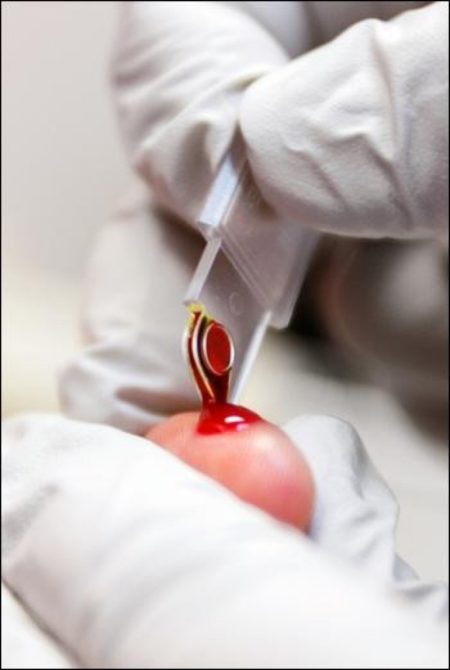
Puncture photo
However, in modern clinics, new devices are used for painless testing - these are automatic lancets with a needle in a plastic container. The needle quickly penetrates the skin of the finger, and no pain is felt. Such lancets have a lot of advantages:
- Guaranteed sterility (the instrument cannot be reused);
- Reliability of the technique for drawing blood from the capillaries of the finger (accidental release of the needle is excluded);
- The shape of the needle does not cause pain;
- Suitable for home use;
- The puncture depth is adjustable;
- The case has a convenient shape.
The video below describes the use of the lancet:
Sample collection algorithm
Taking blood from a finger begins with preparing the instruments:
- Sterile device;
- Cotton wool;
- Iodine solution;
- Alcohol;
- Ether
A man sits down opposite a nurse, puts his hand on the table. The puncture site is first wiped with alcohol and ether to degrease. A puncture is performed using a device to collect a blood sample from the ring finger. The instrument is inserted approximately 2 millimeters into the skin.
The first drop of blood is removed with a cotton swab, and the rest is used for examination. They are collected in a glass container, and then sent to test tubes and smears are made. After taking blood, the finger is disinfected again, treated with iodine solution and cotton wool is applied until the bleeding stops.
Why the ring finger?
Usually the puncture is made in one of the three middle fingers. The little finger is not suitable for these conditions. The fact is that any wound can cause infection. And the three fingers listed have their own inner membrane, so that if an infection occurs, microorganisms will be localized and eliminated before entering the blood. Thumb, like the little finger, are directly integrated with the skin of the hand. If penetrated, the infection can spread throughout the entire arm.
What is a blood sample taken from a finger prick?
Clinical testing can help diagnose various diseases and conditions:
- Leukemia;
- Anemia;
- Helminths;
- Gynecological diseases;
- Coagulation disorders;
- Dangerous infections, for example, syphilis;
- Inflammatory processes;
- Agglutination of erythrocytes.
Decoding
Only the attending physician can decipher the survey answers presented in the form with the table.
Attention! You don’t need to do this at home yourself, relying on generally accepted standards. After all, the doctor can evaluate not only each individual indicator, but also create an overall picture of the patient’s health status.
CBC alone may not be enough to determine serious diseases, so the doctor may ask you to take urine and blood from a vein for biochemistry.









